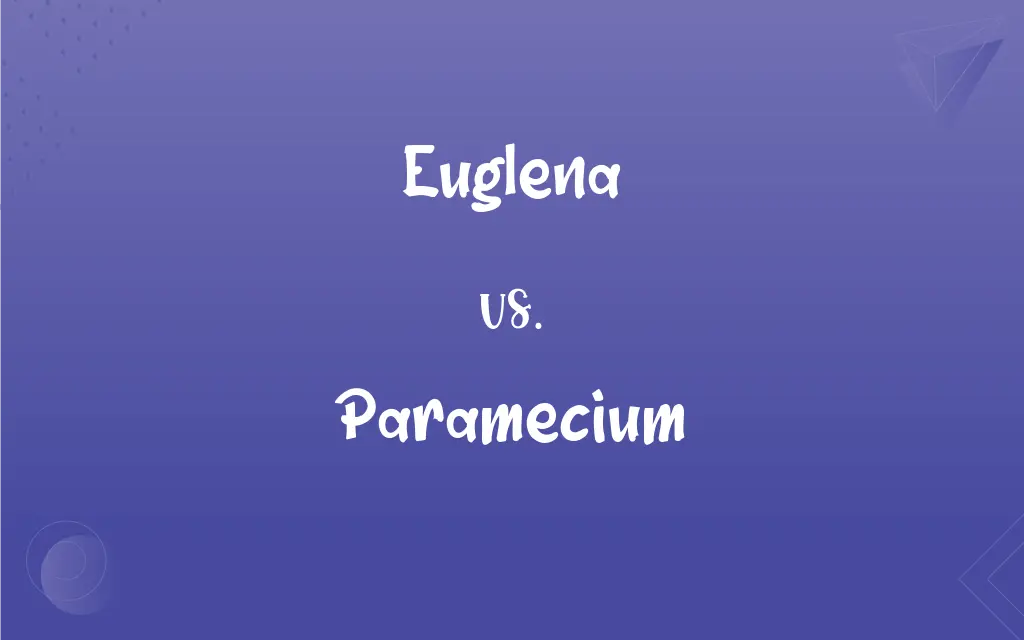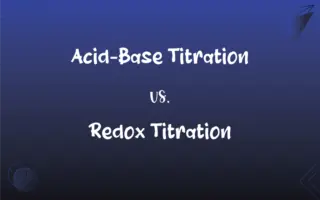Euglena vs. Paramecium: What's the Difference?
Edited by Janet White || By Harlon Moss || Updated on October 29, 2023
Euglena are unicellular organisms with plant-like photosynthesis ability, while Paramecium are ciliate protozoa known for their complex movements.

Key Differences
Both Euglena and Paramecium are unicellular microorganisms found in freshwater environments, but they differ in various structural and functional aspects. While Euglena is a member of the Euglenophyta phylum, known for its dual characteristics of plants and animals, Paramecium belongs to the Ciliophora phylum, known primarily for its ciliated movement. The distinctive feature of Euglena is its single flagellum that aids in locomotion, whereas Paramecium moves using its hair-like cilia that cover its entire body. These features make their movement patterns unique; while Euglena propels forward using its whip-like flagellum, Paramecium moves in a coordinated manner using its numerous cilia.
Euglena exhibits a unique combination of plant-like and animal-like features which differentiates it from Paramecium. One of the notable plant-like features of Euglena is its chloroplasts, allowing it to photosynthesize and produce its food when light is available. Paramecium, on the other hand, lacks chloroplasts and primarily functions as a heterotroph, feeding on bacteria and other small microorganisms. Despite their distinct feeding methods, both Euglena and Paramecium have specialized structures, like the contractile vacuole, which helps in regulating water content within the cell.
Both Euglena and Paramecium have developed mechanisms to respond to their environments. Euglena possesses a light-sensitive eyespot, which helps it detect light and move towards it, optimizing its photosynthetic capabilities. Paramecium, lacking photosynthetic abilities, does not have such an eyespot. However, Paramecium has trichocysts, which are defensive organelles that can be discharged in response to threats, a feature Euglena does not possess. Hence, while both organisms are sensitive to their surroundings, they have different adaptations reflecting their unique life strategies.
In terms of cell shape and structure, Euglena and Paramecium present notable differences. Euglena typically has an elongated, spindle-shaped body which is quite flexible, allowing it to navigate its surroundings effectively. Paramecium, in contrast, has a more rigid, slipper-shaped structure which facilitates its rapid movements using cilia. The structural differences in Euglena and Paramecium not only highlight their unique identities but also showcase the diverse adaptations unicellular organisms have developed over evolutionary timeframes.
Comparison Chart
Nutrition
Photosynthetic and heterotrophic
Strictly heterotrophic
ADVERTISEMENT
Movement
Moves using a flagellum
Propels with cilia
Flexibility
Flexible pellicle
Rigid, structured body
Light Detection
Possess an eyespot
No specialized light detection structures
Environment Adaption
Can switch between photosynthesis and feeding
Solely dependent on ingesting food particles
Euglena and Paramecium Definitions
Euglena
Possesses a flagellum for movement.
The euglena moved gracefully in the water.
ADVERTISEMENT
Paramecium
Ciliate protozoan with cilia.
Paramecium moves rapidly using its cilia.
Euglena
Photosynthetic unicellular organism.
Euglena thrives in freshwater ponds.
Paramecium
Contains a more rigid body.
The paramecium maintains a consistent shape.
Euglena
Can switch between nutrition modes.
Euglena adapts to darkness by becoming heterotrophic.
Paramecium
Consumes particles for nutrition.
The paramecium engulfed bacteria for food.
Euglena
Has a flexible body structure.
Euglena’s pellicle allows it to change shape.
Paramecium
Exhibits complex movements.
Paramecium’s cilia enable agile maneuvering.
Euglena
Contains a light-detecting eyespot.
The euglena’s eyespot aids in finding light.
Paramecium
Lacks photosynthesis ability.
Paramecium depends on external food sources.
Euglena
Any of various single-celled freshwater organisms of the genus Euglena, characterized by the presence of chlorophyll, a reddish eyespot, a single long anterior flagellum, and a second, rudimentary flagellum.
Paramecium
Any of various slipper-shaped freshwater ciliate protozoans of the genus Paramecium, having an oral groove for feeding.
Euglena
(biology) Any of several protists, of the genus Euglena, that contain chloroplasts and a single flagellum.
Paramecium
An oval-shaped protozoan organism of the genus Paramecium.
Euglena
Minute single-celled green freshwater organism having a single flagella; often classed as algae
Paramecium
Any member of the genus Paramecium
FAQs
How does Euglena move?
It moves using a whip-like flagellum.
What is Euglena?
Euglena is a unicellular organism capable of photosynthesis.
Can Euglena survive without light?
Yes, it can switch to heterotrophic nutrition in the absence of light.
What characterizes Paramecium’s movement?
Paramecium moves using numerous tiny cilia.
Does Euglena have an eyespot?
Yes, for detecting light.
Do Euglena reproduce sexually or asexually?
Euglena mainly reproduce asexually through binary fission.
Is Paramecium harmful to humans?
Generally, no. Paramecium is not harmful to humans.
Can Paramecium detect light?
It lacks specialized structures for light detection.
Can Euglena photosynthesize like plants?
Yes, it has chloroplasts for photosynthesis.
How does Paramecium obtain nutrients?
It ingests small particles and microorganisms.
Are Paramecium single-celled or multicellular?
Paramecium are also single-celled.
Is Euglena considered a plant or an animal?
It’s often classified as a protist due to its mixed characteristics.
What is Paramecium?
Paramecium is a ciliate protozoan known for its complex movements.
Does Paramecium have chloroplasts?
No, it lacks chloroplasts and doesn't perform photosynthesis.
Is Paramecium’s body rigid?
Yes, it has a more structured and rigid body.
Where can Paramecium be found?
They are commonly found in freshwater environments.
Are Euglena single-celled or multicellular?
Euglena are single-celled organisms.
What is Euglena’s body structure like?
It has a flexible pellicle, allowing shape changes.
What habitats do Euglena prefer?
They thrive in freshwater environments like ponds.
About Author
Written by
Harlon MossHarlon is a seasoned quality moderator and accomplished content writer for Difference Wiki. An alumnus of the prestigious University of California, he earned his degree in Computer Science. Leveraging his academic background, Harlon brings a meticulous and informed perspective to his work, ensuring content accuracy and excellence.
Edited by
Janet WhiteJanet White has been an esteemed writer and blogger for Difference Wiki. Holding a Master's degree in Science and Medical Journalism from the prestigious Boston University, she has consistently demonstrated her expertise and passion for her field. When she's not immersed in her work, Janet relishes her time exercising, delving into a good book, and cherishing moments with friends and family.































































